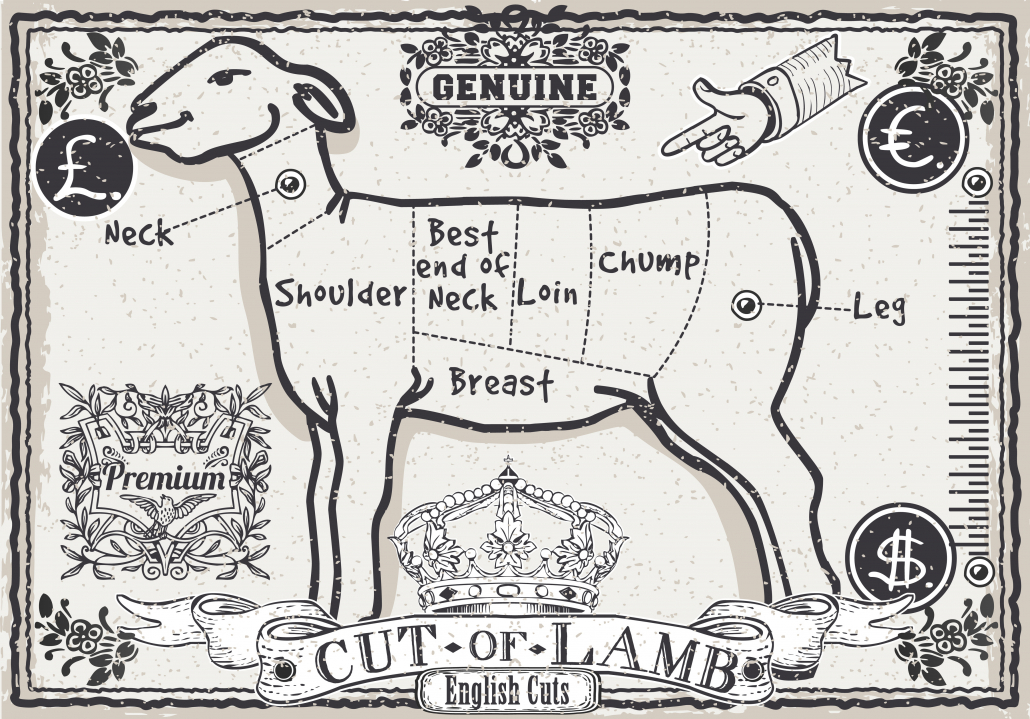We include products in articles we think are useful for our readers. If you buy products or services through links on our website, we may earn a small commission.
Is Lamb Healthy? Nutrition and Benefits of Lamb Meat

If you’re a meat eater or aspiring to be one, you may be wondering, is lamb healthy?
The short answer is, yes. Lamb is an extraordinarily healthy food.
This succulent red meat contains a robust nutritional profile that can provide numerous health benefits.
In this article, we’ll explore everything you need to know about this healthy whole food.
Table of Contents
Lamb 101

Lamb is the meat of young sheep. All lamb is harvested in their first year.
Adult sheep–over a year–are called mutton.
Most people in Western countries eat fresh, unprocessed lamb muscle meat like lamb chops and lamb shoulder.
In other parts of the world where nose-to-tail eating is the norm, common lamb meats include
Though all cuts of lamb are nutrient-dense foods, these organ meats are among the most nutritious foods in the world.

For example, lamb liver is the second highest vitamin B12 food behind only clams, providing 3750% of this essential nutrient per 100 gram serving. While lamb brain provides 1000% your RDV of B12.
Lamb liver also provides 832% of your vitamin A retinol per serving.
Lamb Nutrition
Nutrition for Lamb Chops and Lamb Liver
| Nutrient | Lamb Chops Trimmed to ¼ fat (100 grams) | Lamb Liver (100 grams) |
| Calories | 361 calories | 138 calories |
| Total Fat | 29.6 grams | 5 grams |
| Saturated Fat | 12.7 grams | 1.9 grams |
| Monounsaturated Fat | 12.1 grams | |
| Protein | 22.1 grams | 20.4 grams |
| Carbohydrates | 0 grams | 1.8 grams |
| Phosphorus | 18% | 36% |
| Iron | 10% | 41% |
| Copper | 15% | 349% |
| Zinc | 27% | 31% |
| Vit. A | 0% | 832% |
| Vit. C | 0% | 7% |
| Niacin | 30% | 81% |
| Vitamin B6 | 7% | 45% |
| Vitamin B12 | 100% | 3750% |
| Iron | 10% | 41% |
| Zinc | 23% | 31% |
| Copper | 5% | 349% |
Top 5 Fattiest Cuts of Lamb

For people practicing high-fat, low-carb diets, including the ketogenic diet, the carnivore diet, the Mediterranean keto, and speed keto or OMAD keto, selecting the fattiest cuts of lamb can be a priority.
Here’s a list to point you in the right (fattiest) direction. But keep in mind that it is possible to get each of these cuts with more or less fat depending on how it is trimmed.
We recommend asking your local butcher or farmer’s market meat purveyor for untrimmed cuts of lamb.
Nutrition information per 4 oz.
| Lamb Cut | Calories | Fat | Protein | Carbs | % Calories from Fat | % Calories from protein | |
| #1 | Chop/Rack | 390 | 35.6 | 25.1 | 0 | 80 | 20 |
| #2 | Loin Chop | 330 | 22 | 30 | 0 | 63 | 37 |
| #3 | Leg | 292 | 18.7 | 29.3 | 0 | 59 | 41 |
| #4 | Shank | 276 | 14.7 | 32 | 0 | 52 | 48 |
| #5 | Shoulder | 148 | 6 | 22.8 | 0 | 37 | 63 |
Health Benefits of Lamb
The health benefits of lamb are attributable to a density of nutrients, headlined by healthy fats, complete proteins, and meat specific nutrients like vitamin B12, taurine, and the antioxidant glutathione.
Let’s take a closer look at how these nutrients translate into health benefits.
Healthy Fats Fat

A vast body of recent research tells us that humans evolved eating a diet of primarily fatty meats for more than 2 million years. 1
Some cuts of lamb are fattier than others, but all the fat in lamb is healthy, and some types of fat in lamb are among the healthiest you can eat.
Conjugated linoleic acid (CLA) in Lamb
Lamb provides the highest levels of conjugated linoleic acid (CLA) of any food.
Lamb provides approximately 4 – 19.0 mg CLA per gram of fat content. By comparison, beef typically contains 1.2 – 4.0 mg. While pork and poultry contain less than 1.0 mg.
CLA has been shown to support immune function, strengthen bones, support heart health, and improve excess fat loss.
CLA has also been shown to significantly inhibit the growth of cancer and tumors in the stomach, prostate, breast, and liver.
A 2005 study found that women who consumed at least four servings of high-fat dairy per day had a 34% lower risk of colon cancer.
A smaller study on men consuming 5.6 grams of CLA daily resulted in decreased markers of cancer risk, including tumor necrosis factor and C-reactive protein.
Monounsaturated Fat in Lamb
Lamb chops provide an abundance of monounsaturated fat.
Studies have shown that monounsaturated fat is anti-inflammatory and that consuming it can reduce the risk of heart disease.
Saturated Fat in Lamb
If you’re still afraid of saturated fat, we invite you to let that fear go. The idea that saturated fat is bad for you is based on outdated and faulty observational studies from the 1960s.
Modern studies confirm that there is no link between saturated fat and heart disease. While other’s confirm that saturated fat is in fact, part of a healthy whole foods diet.
The saturated fat in lamb, and especially in lamb tallow (rendered lamb fat for cooking) is extremely satiating.
When you’re satiated, there’s less desire to consume snacks, and it becomes easier to overcome carb addictions.
Omega-3 in Lamb
Meat from lamb that is raised on pasture has similar levels of anti-inflammatory omega-3 fatty acids as some fish, at around 500mcg per 100 grams.
Complete Protein in Lamb
Lamb is a complete protein. This means that it provides all the amino acids our body requires from food in order to support numerous physiological functions.
As a complete protein, lamb is also utilized more efficiently than plant foods that lack certain amino acids.
Protein in lamb promotes lean muscle mass, cellular growth and repair and is highly satiating.
The “Master Antioxidant” Glutathione

Lamb provides the antioxidant glutathione, which has been referred to as the “master antioxidant” due to its many protective functions throughout the body.3
Glutathione has been shown to :
- reduce insulin resistance
- reduce the risk of autoimmune disease
- reduce symptoms of Parkinson’s disease
- protect against oxidative damage in children with autism
In animal studies, higher glutathione levels are associated with a longer lifespan.
In addition to preformed glutathione, lamb also supplies the amino acids cysteine, glutamic acid, and glycine– which the body uses to synthesize glutathione on its own.
Meat-Specific Compounds in Lamb
In addition to healthy fats and proteins, lamb contains numerous beneficial bioactive compounds found only in red meat.
Creatine

Lamb contains approximately 300-500 mg per 100 grams.
Creatine supports muscle growth and maintenance. Recently creatine has been identified as offering antidepressant properties.
Taurine

An antioxidant amino acid has strong antioxidant effects. It has been shown to reduce glycation, reduce inflammation and oxidative stress, and acts as an antidepressant, which accounts in part for the sense of well-being that many people feel after consuming lamb.
Beta-Alanine and Carnosine

Beta-Alanine is a compound found in lamb that your body uses to produce carnosine.
Having high levels of carnosine in muscle tissue has been associated with reduced fatigue and improved exercise performance.
Carnosine itself has numerous benefits, including
- Anti-aging properties that may protect against cognitive decline
- Protects heart, brain, and muscles from wear and tear
- Prevents glycation–a where glucose (sugar) damages cells and DNA
- Antioxidant properties that protect against damage and shortening of telomeres

Vegetarian and vegan diets that are low in beta-alanine may lead to decreased levels of carnosine over time.
Vitamins and Minerals
Lamb is a robust source of various essential vitamins and minerals.
Vitamin B12
A 100-gram portion of lamb rib chops provides 100% of your RDV of vitamin B12.
B12 is an essential vitamin, which means we need to get it from foods. B12 plays important roles in your body, including;
- helping your body convert food into energy
- Forming red blood cells that carry oxygen to the brain
- Boosts cognition, stabilizes mood–a powerful antidepressant
B12 deficiency can result in dementia and is associated with Alzheimer’s disease
Up to 86% of vegan children, 90% of vegan elderly, and 62% of pregnant vegan women are B12 deficient
Vitamin A (Retinol)
Though lamb muscle has modest amounts of vitamin A, lamb liver has the second highest amount of vitamin A of any food.
Vitamin A is essential for immune function, vision, physical growth, and fertility.
And don’t be fooled by the provitamin (precursor) vitamin A in plant foods.
For 55% of people, it is barely absorbed by the body. While for the other 45%, it is essential not absorbed at all due to a genetic mutation.
Studies have shown that retinol absorption efficiency is around 30% 1 hour after consumption. Whereas it is less than 5% for provitamin A carotenoids from plant foods.
While total retinol absorption efficiency ranges between 75% and 100%.
Lamb 101: The Bottom Line
Lamb is a healthy, nutrient-dense whole food loaded with essential macro and micronutrients in near-perfect proportions for your body’s needs.
Lamb is also extraordinarily high in the beneficial fattys acids CLA, and monounsaturated fatty acids.
The bioactive compounds in lamb, including taurine, creatine, and carnosine, may offer anti-aging, performance-boosting, and neuroprotective properties.





















